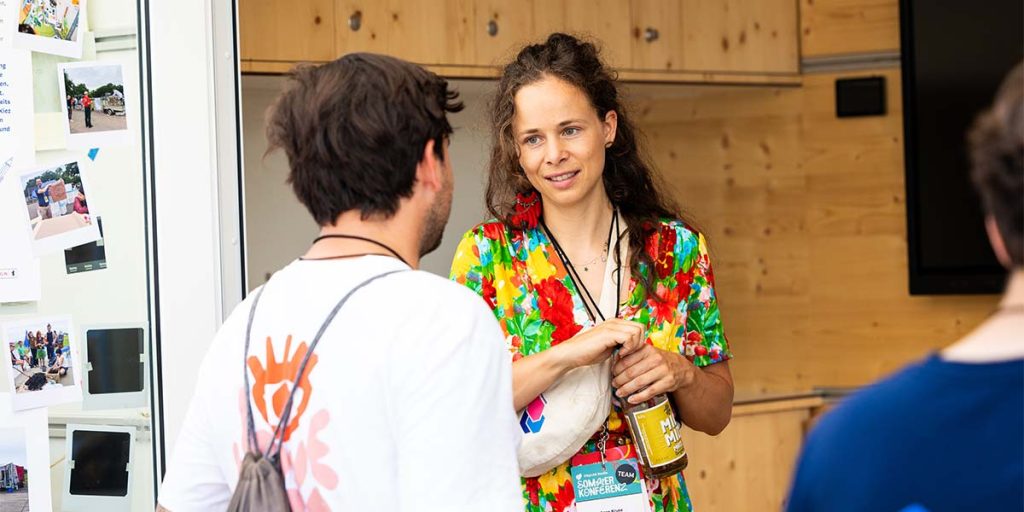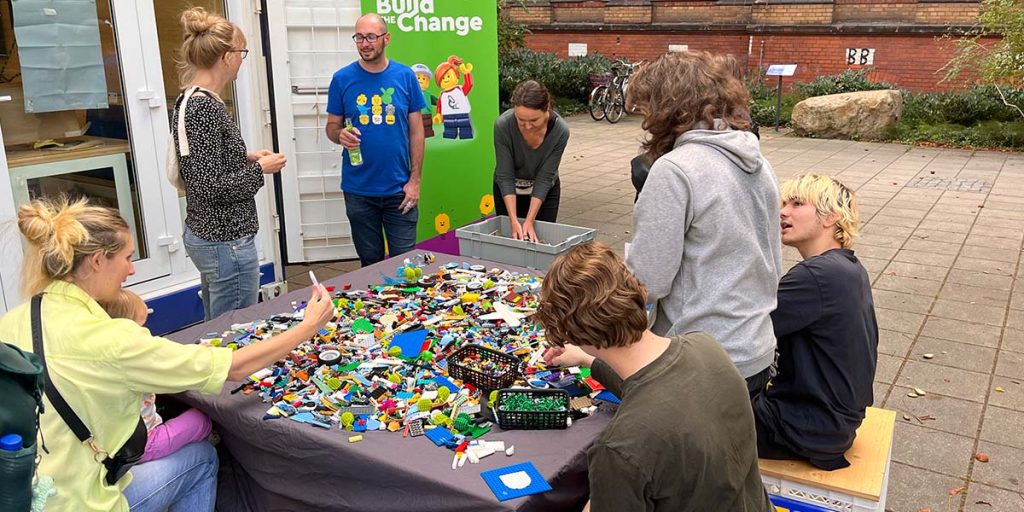From September 10 to October 4, it was anything but quiet in the otherwise quiet library at the water tower in Pankow – the Kiezlabor took place in the immediate vicinity and here it was allowed to be loud and creative! Under the motto “Young in the big city. Opening Spaces, Giving Spaces”, the courtyard was transformed into a lively place where young Berliners and interested parties could actively shape the future of the city. Whether collecting ideas in workshops, neighbourhood walks or heated discussions – everyone was invited to create new spaces for (and with) young people.
Because this was the last location of the year, we asked the team personally about their favorite events and experiences for this recap. Stay tuned to see what they took away from their time in Pankow!

Retro gaming: Resource conservation meets urban development
Léon: “When many young people stay outdoors until 10:00 p.m. despite the cool autumn weather, then something special must be on offer! At the retro gaming workshop with Marten Seedorf, we played retro games on old laptops with the help of free software. Devices that have become unusable for current versions of Windows have been brought back to life with Linux Mint and open-source emulators to rediscover classic games. Instead of writing them off as electronic waste, old devices still fulfil an important function. But it wasn’t just about gambling and resource conservation through upcycling – the workshop showed on a small scale how urban development works on a large scale: It’s about achieving great things with limited resources. In this way, the workshop built a perfect bridge between the core topics of the CityLAB – digitization and urban transformation – and offered young people a playful, low-threshold approach to dealing with their role in shaping their neighborhood.”
With artificial intelligence to a traffic-calmed neighbourhood
Christine: “At the workshop “KIezblock Visions: With AI to a traffic-calmed neighborhood”, young visitors were given the opportunity to first take a walk through the Winsviertel with Group F, where confusing traffic moments could be identified and photographed, before it was then in the Kiezlabor edited the captured images himself. Despite the rainy weather, young visitors took the opportunity for a walk or came together directly in the container to discover the UrbanistAI platform and redesign squares and streets. Food trucks and trash cans were at least as important as green meadows and water playgrounds, but it also showed how deeply the focus on the car in road traffic is anchored in thinking. Personal dreams such as a white villa with a garden were of course also visualized. One visitor in particular, after having only explored the outside of the Kiezlabor the day before, dared to get closer and had a lot of fun changing pictures. It has been shown that we can always learn new things: In some places, we noticed that there is still potential to become more familiar with the platform – an exciting learning curve for all of us!”
LEGO: A playful approach to the big issues of our time
Anne: “Numerous families and young people looked at the workshop “Let’s create the future!” where ideas for the future of the neighbourhood were tinkered with a variety of materials. Also in the workshop “LEGO: Build the change!” It was lively: young and old experimented together with LEGO and developed solutions to the challenges of the climate crisis, such as: “Build something that can protect bees from climate change.” This resulted in creative ideas such as bee-friendly plants in the city, green roofs or breakwaters to protect turtles. LEGO in particular attracts people because it allows for a playful approach to complex topics. By building and experimenting, participants can turn their ideas into tangible prototypes, which helps to explore challenging topics in an understandable and fun way. It turned out that people, regardless of their age, enjoy playing with LEGO. The workshop attracted many interested people who might not otherwise deal with these topics, and opens up a wide range of opportunities to deal with even challenging questions in a playful way.
Our goal with the Kiezlabor is to talk about future-relevant topics in an accessible way. So building prototypes with LEGO and cardboard is a great way to do that.”


Kiezpuls: Hands-on opportunities for everyone
Julian: “In addition to our events, we always offer small hands-on opportunities in the Kiezlabor, which enable residents to participate in the events in a low-threshold and spontaneous way. Since the middle of the year, we have been collecting mood pictures from the neighbourhoods with our Kiezpuls exhibit and this format was particularly popular in Pankow. It was found that people in the surrounding neighbourhoods are most willing to do without parking spaces in public spaces and prefer to move around on foot or by bicycle. We share these valuable insights with local stakeholders to incorporate community needs into future planning.”

Visions of the future and creative interventions in urban space
Caro: “System designer Nathalie Sterzenbach has designed the “Glass Chain” workshop for the Kiezlabor, which is based on the Bauhaus philosophy and Lucius Burckhardt’s walking research. Together with young people and other interested people from the neighbourhood, we asked ourselves the question “What if…?” and developed speculative visions of the future for Pankow. After a walk through the neighborhood, models were created from AI-generated texts, first sketches and urban street furniture made of cardboard. It was about small interventions in urban space, such as opportunities to sit (without having to consume right away). Sometimes that’s enough, and it doesn’t always have to be big changes, says Nathalie Sterzenbach. In addition, ideas were also discussed on how to redesign the inner courtyard of the library at the water tower. A telephone booth with books would be nice, trampolines embedded in the ground or cool street furniture for climbing and reading. The existing lights in the floor could also flare up and invite you to an interactive game. But here, too, the courtyard is a great alternative place, especially because there is not so much going on there, according to the neighborhood residents. This should be taken into account in the future redesign.”

Constructive exchange and lively discussions in the Kiezlabor
Henriette: “The redesign of a neighbourhood initially leads to a lot of material for discussion: from open questions to praise, concerns and criticism – especially in Berlin, especially when it comes to parking spaces. This is also the case with the planned neighbourhood blocks in Pankow. For this whirlwind, the entire planning team spent several days ranswering questions in the neighbourhood laboratory.
Many players, high crowds and numerous media – and all this around one container. The Pankow district office was available to answer questions, Group F supported the participation process, and ChangingCities provided information about residents’ applications . Thus, the lively discussion shifted “from the comment column to reality”, as Florian Keiper of Chang inghCities wonderfully put it. Strings were stretched to show desired cycle paths, lively discussions were held on boards or possible visions of the future of the roads were visualised on the screen with an AI tool.
In this way, the Kiezlabor once again managed to offer space for constructive exchange and to make visions of the future a reality. To hear all the voices and meet in the middle – that’s exactly what the Kiezlabor is for.”

Stefan: “At the event “Kiezblocks for Pankow – Help shape the traffic turnaround!” the Pankow district office came by to provide information on the topic of neighbourhood blocks. What began as a consultation hour and information event very quickly turned into concrete wishes for the design of the neighbourhoods. An astonishing number of people were there to present their concerns and to talk specifically about the planning of pedestrian and bicycle traffic. Both the size of the participants and the intensity of the discussion made it clear how much planning and design potential there is in participation formats. The possibility of an open consultation hour on topics that directly affect the people in the neighbourhood was gratefully accepted. However, the homogeneity of the group that took part in the program item was also striking, which indicates a possible deficit of the format. In addition, it became clear that the residents want to actively participate in the design of their neighborhood. This made it possible for the Pankow district office to take up the concerns and make their work more transparent.”

Here’s to another exciting year with the Kiezlabor!
At the end of an eventful year, the Kiezlabor team can look back on numerous inspiring events and valuable encounters. Whether in creative workshops, intensive discussions or joint neighbourhood explorations – it has been shown time and again that the interest and participation of people in the neighbourhood remains high. In particular, the diverse approaches with which complex topics were presented in a playful and accessible way have enabled us to include many different voices and perspectives.
With these positive experiences in our luggage, we are already looking forward to the many exciting events and neighbourhood explorations that await us next year. We can’t wait to develop creative ideas together with you again and shape the future of our city!
